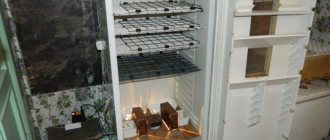How to build a house: basic tips
Many owners who built a private house on their own claim that the desire to save money will lead to large expenses. When they rely on an approximate estimate instead of a detailed calculation, the amount of expenses increases significantly. What you definitely shouldn't skimp on is engineering support.
How much does it cost to build a house? It depends on the decisions made. Here are general recommendations:
- The simpler the layout, the cheaper and with fewer errors the building will be erected.
- It is more profitable to build an attic floor than a second floor with a full concrete covering.
- According to the experience of other builders, the biggest expense is not the frame, foundation and roof, but finishing and engineering.
- A competent project is important. You should not start construction without working out engineering communications, wiring inputs into the house, drawing components and a roof design.
- You shouldn’t skimp on hiring technical supervision services. As a result, you will save 15-20% of the estimate and get a home that serves well.
Let's consider construction methods, as well as the necessary materials.
Where to start building a house, preparation and next steps
At this stage, you will need to resolve a number of important issues: select a place for construction, determine the construction budget, purchase a cottage project, issue a building permit and select a contractor. All these issues are equal in importance, and everyone will have to pay a lot of attention.
Preparatory stage of construction
For those who do not know how to build a house correctly, experienced developers advise starting the process by purchasing a plot of land or concluding a long-term lease agreement. Next, a mandatory package of documents is prepared, the composition of which is determined by urban planning regulations. The list of documents in the package may partially change, based on the characteristics of the region and the number of floors of the building under construction.
When purchasing a plot of land, you should not completely trust the seller’s information; you need to check everything yourself.
Note! Immediately after completing the procedure for acquiring a land plot, you need to fence it. It is also important to allocate a place where the concrete solution will be prepared, waste will be stored and removed. This will make it possible to protect the area from litter.
Frame technology
This is a fast and economical method of construction; the frame does not deform or sag over time. Construction of a house is carried out in two ways:
Photo: pinterest.com/woodformsdesigns: UGC
- panel;
- shield
The first option takes longer because it consists of the following steps:
- erection of a wooden frame;
- laying insulation and insulation;
- paneling.
The panel option will save time, but increase costs. The house is being built from a ready-made SIP panel, which only needs to be installed. The frame can be made of wood or metal profiles. The advantages of wood are naturalness and lightness, but the wood must be additionally impregnated to protect it from fire, water and insects.
The lightweight thermal profile guarantees fire safety, light weight and longer service life than wood. But it also needs protection against corrosion.
Preparation of the project and its connection to the area
If the developer has chosen a standard project to build a house, it must be tied to the area. Therefore, the building is removed to its real size. This process is mandatory and is aimed at establishing the optimal location of a residential building on the ground, taking into account climatic parameters, soil characteristics and the allocation of boundaries of private households.
Since standard projects are generally not designed for seismic areas, when they are tied to a location, as a rule, it is not possible to increase the seismic resistance of a structure. Therefore, you will need to change the space-planning solution, the stages of building a house, or abandon the taken design documentation and choose another option that takes into account this important parameter.
The binding project must include two mandatory drawing sheets:
- Situation plan, M1:2000.
- General plan, M1:500.
The first sheet indicates the plan of the land plot on the construction site, and the second sheet contains the building site of the cottage with various auxiliary outbuildings and a garage. The fundamental point is the unmistakable location of the building on the land plot according to the cardinal directions, in accordance with the regulatory and technical framework.
How to build a brick house
Brick is one of the most popular materials due to its reliability and decorative characteristics. But this approach will not save money. Here are the disadvantages when choosing a material:
Photo: pinterest.com/dizajninterera1: UGC
- laying thick panels for walls;
- long-term formation of masonry;
- temporary shrinkage;
- using a mixture for styling;
- the need to lay a strong foundation.
Here are the significant advantages:
- reliability and durability of the structure;
- brick is not afraid of external factors;
- environmental friendliness;
- good sound insulation, fire safety;
- high aesthetic characteristics.
When choosing a brick, it is important to understand that you need to constantly live in the house and heat it. If no one lives in the building for a long time, and the heating is turned on periodically, moisture will accumulate between the heated inner wall and the cold outer one. This destroys the house from the inside.
Construction of the foundation for the building
Similar to other capital projects, the construction of a frame house requires the construction of a foundation. At the same time, it is inappropriate to build a powerful reinforced concrete foundation for a building whose standard service life is no more than 100 years, and when developing a basement, it will be necessary to take into account the level of groundwater.
The most common foundation for a frame house is considered to be a strip foundation, which is poured below the freezing point of the soil. Thus, it compensates for the movement of soil and makes it possible to proportionally distribute the load created by the house on the soil.
Table of the minimum depth of laying a strip foundation
| Soil freezing level, cm | Foundation level, cm | |
| Slightly heaving soils | Non-heaving soils with hard rocks | |
| > 240 | No | 150 |
| 140 — 240 | > 300 | 100 |
| 100 — 150 | 200 — 300 | 80 |
| < 100 | < 200 | 50 |
Pouring such a foundation has technological features:
- A necessary condition is considered to be reinforcement around the perimeter of the structure, and the reinforcement must be secured to each other using wire knitting.
- To make the foundation, only freshly prepared concrete mortar, grade M 200 and higher, is used.
- The foundation must stand before the construction of the frame.
- An integral process should be waterproofing the foundation.
Construction of a house from aerated blocks
Lightweight and easy to use building material will allow you to quickly build a structure. Aerated concrete has its pros and cons. But if you calculate everything, then the material can be considered ideal in terms of price/quality/speed of construction.
Photo: pinterest.com/banyavchane: UGC
Advantages of gas blocks:
- low construction cost;
- safety and environmental friendliness;
- lightweight material cuts well and can be quickly installed using glue;
- the ability to build a house of any configuration - with arches, kinks;
- fire safety.
There are also features. There are aerated concrete of various modifications, and this is important to consider during construction. Thus, the D400 B2.5 material retains heat well, but is less resistant to stress. And aerated concrete type D600 B3.5–5 is durable, but its thermal conductivity is higher. Ideally, builders recommend building walls in two rows with bandaging, making the outer layer of durable material and the inner layer of warm material.
There is another important factor. Aerated blocks absorb moisture very quickly and then release it. Therefore, the house requires mandatory plaster, preferably two layers.
From simple to royal. Construction with taste (master class)
KAZAKHSTAN REPUBLIC
School of education "Deep technical colleges" KMM
Verkhneberezovsky k.
MINISTRY OF EDUCATION AND SCIENCE OF THE REPUBLIC OF KAZAKHSTAN
Department of Education of East Kazakhstan Region KSU "Glubokovo Technical College"
Verkhneberezovsky village
“Karapayimnan patshalykka deyin. Talgamdy kurylys" master classes
Adistemelik azirlemesi
Methodological development
Master class “From simple to royal. Construction with taste"
Mamandygy, code:
“Gimarattardy men kurylymdardy salu zhane paidalanu”, 1401000
Specialty, code:
"Construction and operation of buildings and structures", 1401000
Biliktilik, code:
"Sylakshy", 1401042
Qualification code:
"Plaster", 1401042
Ө/about sheberi: A.A. Krutikova
P/o master; Krutikova A.A.
Plan for the master class profession: “Plasterer”
Date: April 20, 2015.
| Master class topic | «From simple to royal. Construction with taste » |
| Purpose of the master class | To familiarize and interest the schoolchild in this profession, familiarization with the profession, its historical background, role in the economic development of the Republic of Kazakhstan, general information about the profession, familiarization with safety and industrial safety in the training workshop “Plaster”, testing the student’s capabilities based on this course covering the main areas of knowledge, allowing one to form an idea of the nature of people’s professional work based on personal experience. |
List of literature used when preparing the lesson:
|
Distribution of time by stages.
| Organizational part | Induction training | Knowledge test (conversation) | Current briefing | Final briefing | Sanitary and hygienic measures | ||
| exercises | Independent work | ||||||
| 5m. | 45m. | _____ | 30 min | ______ | 5m. | 5m | |
| Material and technical equipment of the lesson | Workshop "Plaster", work simulators. Tools and accessories: spatula (10 cm) – 15 pcs, spatula (from 20 to 40 cm) – 15 pcs, dry plaster “Alinex” – 50 kg, mortar boxes – 15 pcs, figured rollers – 15 pcs, construction mixer – 1 pc. Methodological equipment: Instructional and technological maps “Preparing the surface for plastering”, “Finishing the surface with decorative plasters”. Video clips “Types of decorative plasters, finishing methods”, “Plastering works”, “New technologies in construction”, etc. Presentation during the lesson. | ||||||
I. _ Contents of the induction training
1.Check availability of students
.
2.Communicate the topic and purpose of the lesson
: Master class “
From simple to royal.
Construction with taste ." To familiarize and interest the schoolchild in this profession, familiarization with the profession, its historical background, role in the economic development of the Republic of Kazakhstan, general information about the profession, familiarization with safety and industrial safety in the training workshop “Plaster”, testing the student’s capabilities based on this course covering the main areas of knowledge, allowing one to form an idea of the nature of people’s professional work based on personal experience.
3. Organizational moment:
(5 minutes)
(Getting to know the group. Creating a favorable working environment).
The floor is given to the master of industrial training for the profession of “bricklayer” Kairat Samal (3 min).
The master of industrial training, Anastasia Aleksandrovna Krutikova, speaks.
— Hello, our dear “guests.” We present to your attention the profession “Plaster”. We spend most of our precious time indoors, either at work or in our own home, as well as shops, theaters and cinemas, in your case it is school, etc. And it is very important what the interior of the room is, we try to try new market products. I am a third-year master of industrial training: Krutikova A.A., also a second-year master of industrial training: Emelyanova Irina Gennadievna, first-year master of industrial training Kairat Samal, master of training: Aidarkhan Kenzhekhan. Today we will all introduce you to this profession.
I build entire villages, I even build cities!
build
carefully, you need to build to last. So that you can live in warmth, comfort, even in heavy snow,
In
my house I am an artist, and I am a commander over laziness. You guessed it, I, the Builder, am the most honorable citizen of all. Construction
is one of the most ancient professions.
It appeared many years ago, when people came out of the caves and began to build homes for themselves. Palaces, temples, castles, towers, bridges built in ancient times continue to delight with their architectural splendor even now all over the world. Any construction is a matter for a whole team of workers, where each person has his own specialization and performs a specific job. To build a house, you need people of different professions, who are united by one goal and task, the construction of a modern, comfortable, beautiful and reliable house. The main professions of people taking part in the construction of our schools: designer, architect, tractor driver, bulldozer operator, excavator operator, driver, bricklayer, concrete worker, installer, roofer, crane operator, carpenter, carpenter, plasterer, molarist, electrician, plumber, welder, civil engineer . Thanks to such people, their skill and diligence, professionalism, love for their work, we feel cozy and comfortable in the built houses and institutions. History of the profession:
The historical profession developed back in ancient times, when construction work was carried out by multimillion-dollar “work collectives” consisting of slaves. Later, this work moved into the category of hired labor, becoming entrenched in the minds of modern residents of megacities. Social significance of the profession in society: In connection with the development of the construction industry in large states and private investments in urban construction, the profession of a builder is becoming more relevant at the moment. Mass character and uniqueness of the profession: The profession of a builder belongs to the category of mass professions. Responsibilities include performing a full range of repair and construction work with mandatory compliance with safety regulations. In order to engage in such a business, it is necessary to have knowledge of the basics of construction work, as well as mandatory skills in mastering general and specific construction tools. Personal qualities include hard work, perseverance, attentiveness, accuracy, perseverance and the desire to complete the work started. Moreover, excellent physical fitness, sufficient health indicators, as well as endurance will ensure high productivity when working both outdoors and indoors.
Performers. This includes a fairly wide range of construction workers:
• mason. Builds and repairs houses, bridges and other engineering structures. At the same time, the master works with different types of materials, both natural and artificial. A mason lays walls and foundations, installs slabs and floors.
• roofer. Engaged in the preparation and installation of roof coverings. The specialty is very responsible, because the quality of the work performed determines how warm and dry the house will be.
• electrician. Installs wiring and lighting in residential areas. Installs various electrical equipment in production: electric motors and transformers. Electricians install cable and overhead lines.
• electric and gas welder. Performs work on cutting and welding metal parts and structures using gas or electric arc welding. This worker is one of the main figures on the construction site.
• painter. Apply putty, paint walls, glue wallpaper. Highly qualified specialists can also perform artistic decoration of ceilings and walls, create colors, and paint various surfaces.
• facing. His responsibilities include preparing the solution, selecting paint and special compositions, preparing surfaces and creating mosaic and tile coverings. The master veneers the floors, walls and details of architectural structures with marble.
• finisher. A specialist in the design of various types of surfaces in order to give them a finished look. Masters of this specialty are familiar with all modern technologies and materials. They know how to glue wallpaper, perform painting, plastering and tiling work, treat wooden surfaces, lay carpets, etc.
Personal qualities of a builder
People of this profession have great endurance and physical strength. The places where you have to work are very diverse and sometimes difficult to access, so mobility and flexibility not only of the hands, but of the whole body are necessary qualities. Some specialties involve monotonous work, so you should be able to focus your attention for a long period of time. For this profession it is necessary to have a good linear eye, light perception and acute vision.
To become a highly qualified master, you must have not only spatial imagination, but also technical thinking. Patience, accuracy, balance, diligence, and organization are integral qualities in the construction profession.
Education: what do you need to know?
Sometimes, in order to master a particular construction specialty, it is enough to simply learn the craft directly on a construction site from experienced and knowledgeable craftsmen. At the same time, they will also pay. But, of course, for a higher paid job it is worth getting a secondary specialized education. Having a higher education will be a great advantage for those who want to grow in their career.
To perform construction work efficiently, specialists in this field need to know the specifics of using professional tools and equipment. It is important to always follow safety precautions.
Universal craftsmen who master several specialties are in great demand. Such builders will accordingly be paid higher wages.
Place of work and career
The areas of application of this profession are vast. These include construction sites, factories, and manufacturing enterprises. It should be noted that the demand for builders in spring and summer is much higher than in the cold season.
Career growth involves performing more complex work or increasing the rank, which will allow a specialist to earn more. Those who also have the ability to lead can easily count on the position of foreman or foreman. If desired, the builder can also engage in individual entrepreneurship, providing services to the population.
Unfortunately, blue-collar jobs are not so popular among young people. But taking into account the fact that the number of construction projects is growing every year, we can confidently say that construction is the profession of the future. The labor market does not stand still. Some specialties disappear without a trace, while others become more relevant. The construction profession is in ever-growing demand. These specialists will never remain on the sidelines of life and will always be able to feed themselves.
……..In statistical accounting and economic analysis, real investments are also called capital-forming. Capital-forming investments include the following elements: . investments in fixed capital; . capital repair costs; . investments in the acquisition of land plots and environmental management facilities; . investments in intangible assets (patents, licenses, software products, research and development, etc.); . investments in replenishing inventories of working capital. The main place in the structure of capital-forming investments is occupied by investments in fixed capital, the volume of which includes the costs of new construction, reconstruction, expansion and technical re-equipment of existing industrial, agricultural, transport, trade and other enterprises, costs of housing and cultural construction. Investments as an economic category perform a number of important functions, without which the normal development of the economy of any state is unthinkable…….
Showing videos on the profession “New technologies in construction” (10 min)
4. Safety precautions in the training workshop “Plaster”
.
Safety rules in the training workshop
profession "Plasterer"
Each newly admitted student is allowed to work in the training workshop only after an introductory briefing on safety precautions, fire safety and industrial sanitation, as well as initial instruction directly at the workplace with demonstration of safe techniques and work methods.
Each such briefing is recorded in a journal in accordance with the statutory form.
People can start working in the workshop only with the permission of the master.
Students are required to have a medical examination.
Safety requirements before starting work:
Students who do not have special clothing, safety helmets and other necessary personal protective equipment are not allowed to perform work.
Before starting work on scaffolding and scaffolding, it is necessary to check their reliability, fastenings, and the presence of guards.
Smoking is prohibited in workplaces.
To protect students from electric shock, all temporary electrical installations are made with insulated wire.
Electrical panels must be covered and marked “do not touch with hands”.
Safety requirements during operation:
During the work process, the plasterer must fulfill the following requirements:
Monitor the serviceability of hand tools.
Work strictly with gloves.
Wear safety glasses when cutting and hewing bricks.
Fence completed openings or insert window or door blocks into them.
Safety requirements upon completion of work:
Upon completion of work, clean your workplace, clean and wash the tools.
Leave the workplace only with the permission of the industrial training master.
At the end of the industrial training lesson, the students on duty clean the training workshop.
4. Presentation of new material
:
Dry mixtures for plastering walls
Plastering walls in an apartment is one of the most difficult types of finishing work. It will be a pity for the wasted effort and money if, after drying, the plaster starts to crack, or if it moves away from the wall altogether. Therefore, the quality and type of plaster mixture with which you will level the walls plays an important role.
- 2.2.1 Advantages
- 2.3.1 Advantages
The mixture is easy to prepare yourself. To do this, select the components, sift the sand, mix in the required proportions and dilute with water. All this takes a lot of time. The mixture often turns out to be of poor quality.
Manufacturers of building mixtures have taken care of you for a long time. There is a sufficient quantity on sale
dry mixtures for plastering walls.
All you have to do is choose what exactly you need to buy.
How to choose a mixture for plastering walls
The choice of plaster mixture depends on the surface of the wall, the ease of use of the plaster, and the time that you can afford to carry out the finishing work. Of no small importance is the cost of the mixture for plastering walls.
In order not to make a mistake in choosing a mixture, it is important to know what types of plasters are available and what they are intended for.
If you have to finish the facade, you have two options - cement or cement-lime mixture for plastering the walls.
For finishing indoor walls, in addition to cement and cement-lime mixtures, there is a third option - gypsum-based plaster mixtures. The three options are more difficult to choose from. To make your choice easier, check out the advantages and disadvantages of each type of plaster.
Dry mixture for plastering walls is produced in bags of 25-30 kg, as shown in the photo.
What are the dry mixes for plastering walls?
Depending on the fillers, plaster mixtures are produced
- cement
- cement-lime
- plaster
Cement plaster
The main components are cement as a binder and sand as a filler.
Advantages
- Suitable for both interior and facade work.
- long viability of the solution - this allows you to mix several bags of the mixture at once with a concrete mixer without fear that the solution will set and you will not have time to work it out
- durable surface after drying, resistant to mechanical stress
- low cost
Flaws
- does not adhere well to smooth concrete surfaces
- long time for cement to harden - further finishing begins after no less than 2 weeks; further finishing requires putty
- inability to complete a large amount of work in one day due to heavy physical activity; increased humidity in the room during drying. To crystallize cement particles, a sufficient amount of moisture is necessary, so it is recommended to spray the plastered surface with water. Increased room humidity leads to deformation of wooden structures.
- dirty job. When throwing mortar onto the wall, a considerable part of it will end up on the floor, which in itself is unpleasant - when there is a lot of dirt under your feet. Cement particles have a very fine fraction; when mixing the mixture, they rise into the air and enter the respiratory tract, which is harmful to health.
Cement-lime plaster
Composition: lime, cement, sand.
Advantages
- used for external and internal work, as well as for rooms with high humidity
- has antibacterial properties, which protects against the appearance of fungus
- elastic in consistency, making it easy to apply
- has good adhesion to the surface
Flaws
- long final drying time - 3-4 months
- very demanding in terms of technology - with the slightest deficiency in surface preparation or failure to follow drying rules, cracks appear on the plaster or the wall becomes loose
- dust from the lime plaster mixture is very harmful to health, the solution getting on the skin causes irritation and ulcers may appear
Gypsum plaster
The composition of the gypsum mixture for plastering walls includes gypsum and fillers in the form of mineral additives. The color of gypsum plaster is gray, cream, or white.
Advantages
- quick drying of the plaster allows finishing work to be completed in a short time
- does not require putty to prepare walls for wallpapering
- very flexible, does not slide off the wall during operation
- It is enough to apply one or two layers, which allows you to plaster 30-40 squares of the prepared surface per day
- less dirt and dust than when working with cement mixtures
- non-shrinking, does not crack after drying
Flaws
- low viability of the solution - the prepared mixture must be worked out within 40 minutes
- the finished plastered surface is unstable to mechanical stress
- not resistant to moisture, for this reason it is not used for outdoor work
Adhesive plaster
Composition: cement, polymer additives, special fibers, sand.
Mainly used for installation of insulation. Can be used to plaster the entire wall using mesh. The high cost of this plaster limits its widespread use for leveling walls.
What to consider when purchasing dry plaster mixtures
• Do not purchase mixtures from little-known manufacturers.
The German company produces very high-quality mixtures for plastering walls. The price for this company's products is slightly higher than for mixtures from domestic producers, but counterfeits are also more common than for Russian mixtures.
Among the domestic manufacturers, “Yunis”, “Osnovit”, “Kreps”, “Volma” have proven themselves.
The quality of prospector mixtures is not inferior to Knauf mixtures. When purchasing large quantities, the difference of 100 rubles per package of 30 kg becomes noticeable.
• Walls made of foam concrete have a porous surface; it is better to level them with gypsum mixtures. Cement mortar can also be used. But due to the fact that foam concrete absorbs moisture well, the plastered surface will have to be sprayed with water several times.
• Wooden walls are plastered with a cement-lime mixture over the installed shingle sheathing.
• In terms of cost, gypsum plaster mixtures are more expensive than cement ones. But, if you consider that the consumption of gypsum plaster is 10 kg per square meter with a layer thickness of 1 cm, and cement plaster is 13-16 kg, then it turns out that it is not much more expensive.
• Do not purchase mixture for plastering walls in large quantities. Unfortunately, there are a lot of fakes on the market. First, take a couple of packages and try them out. If the setting time meets the standards, you can buy the required amount of the mixture. Gypsum plasters that have been stored incorrectly very often set within 10 minutes after mixing. Cement plasters, to which you “forgot” to add the required amount of cement, will slide down the wall.
High-quality mixtures are packaged in three-layer packaging. There must be a layer of film between the outer and inner paper layers. The release time of the mixture indicated on the packaging should differ by at least one second.
A good video about choosing plaster mixtures and their disadvantages, but the advice on mixing cement and gypsum plaster is unclear. You don't need to listen to this advice.
Screening of the video “Technology for applying ready-made mixtures” (6 min)
5.Demonstration of step-by-step implementation.
Demonstration of applying a putty layer to the simulator at a working pace, then at a moderate and slow pace, with a commentary on each element of the operation of performing the work, then again at a working pace. Applying a design to a freshly applied layer using curly rollers, a glove, etc.
Testing those who wish.
Demonstration of drawing a picture using a regular file or a plastic bag containing a crumpled sheet of paper, also using a sponge, etc.
Demonstration of applying a pattern using shaped rollers with various pattern coatings.
Drawing with a construction brush.
Application schemes.
Application using a regular spatula measuring from 5 cm to 10 cm.
Application using cycles or special spatulas.
6. Organization of labor and workplace, safety measures.
7. Distribution by workplace.
- Current briefing.
Walking around workplaces to:
1. Compliance with workplace organization, safety regulations and
fire safety.
2.Checking and assistance in performing training exercises: applying a putty layer, leveling it, applying a pattern.
III.Final
briefing.
1. Summing up the achievement of the goal.
2. Summing up the work analysis (quality of work performed).
3. Typical errors, ways to prevent errors.
Senior master___________ Shiryaeva V.V.
Master P/O___________Krutikova A.A.
Houses made of timber
Wooden buildings are environmentally friendly, light, beautiful, and therefore often attract the attention of those who are going to build a house. But do not forget about the peculiarities of working with wood. Here are the main advantages:
Photo: pinterest.com/imgur: UGC
- Low cost of construction. All thanks to the lack of a massive foundation, manufacturability and availability of the material.
- Fast construction time. Often, prepared sets of elements are used for construction.
- Natural material regulates humidity and temperature in the room.
- There is no need for interior decoration, because the timber looks aesthetically pleasing.
- High-quality thermal insulation.
Disadvantages:
- Fire hazard. The timber must be coated with a special impregnation that prevents fire.
- Aging of wood, which is susceptible to external factors.
The last point is leveled by the correct approach to construction, the absence of cracks and treatment with antiseptics. If everything is done correctly, the house will last from 50 to 100 years. But timely care of wood can significantly extend the life of a home.
Conducting geological and geodetic research on the site
Before building a house, it would be correct to study the properties of the soil on the site based on geological and geodetic studies, during which the following data is obtained:
- On the physical and mechanical characteristics of soil.
- Information about the geological structure of the earth.
- Level of location of groundwater.
- Soil strength.
- Chemical-corrosion potential of soil.
This information will help determine the location of drilling a well or constructing a well to supply water to the house, as well as choose a method for designing the future foundation.
Option #3 – aerated concrete blocks
Aerated concrete block is a worthy competitor to traditional brick. Building a box is significantly more profitable than erecting it. The wall thickness can be reduced by 1/3 without losing its thermal insulation properties. The material itself is noticeably lighter, which allows for savings at the expense of the foundation. An additional “bonus” for the home owner is good sound insulation.
A dwelling made of aerated concrete blocks “breathes”; air exchange in it is not impaired, because through pores. However, for the same reason, blocks are considered not the best option in terms of waterproofing. If construction is carried out in violation of technology, the finished structure may also be blown out. You need to pay attention to the finishing.
As for the construction time, an aerated concrete structure can be erected 2-3 times faster than a brick one; it practically does not shrink. Special adhesives are used to connect the blocks. In this case, it is undesirable to use ordinary cement mortar, because... it produces thick seams, which can cause the formation of “cold bridges”.
One of the disadvantages of aerated concrete blocks is their relatively low frost resistance, so you will have to take care of high-quality finishing. The materials you can use are plaster, siding, stone











